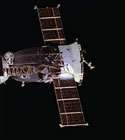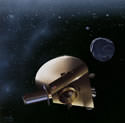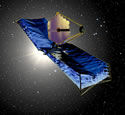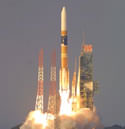Because of Hurricane Lili bearing down on the Gulf Coast of the US, NASA flight controllers decided to delay the launch of the space shuttle Atlantis until Monday. At agency headquarters in Houston, the agency began precautions to shut down computers and evacuate the area if the weather conditions worsen ? they also transferred control of the International Space Station to Moscow. Ironically, the weather at the launch pad in Florida was perfectly clear.
Progress Docks with International Space Station

Image credit: NASA
After four days in space, a Russian Progress M1-9 docked with the International Space Station on Sunday afternoon at 1701 GMT (1:01pm EDT). The unmanned cargo vessel carries 2.6 tons of food, fuel and equipment for the station. The operation took a little longer than normal because Russian controllers used the opportunity to test the Kurs automated docking system employed on the Zvezda module.
An unmanned Russian resupply craft successfully docked to the International Space Station Sunday, bringing almost a ton of food, fuel and supplies to the residents on board, and for the next trio of space travelers, which will arrive on the ISS in November.
The Progress 9 vehicle linked up to the aft docking port of the Zvezda Service Module of the ISS at 12:01 p.m. Central time (1701 GMT) as the two spacecraft flew over Central Asia after a four-day flight following its launch Wednesday from the Baikonur Cosmodrome in Kazakhstan. The automated docking went off without a hitch as Expedition 5 Commander Valery Korzun, NASA ISS Science Officer Peggy Whitson, and Flight Engineer Sergei Treschev viewed the arrival of the new capsule from inside Zvezda. A few minutes later, hooks and latches closed between the two vehicles to form an airtight seal.
Korzun was prepared to take over manual control of the Progress for the docking in the event its automated rendezvous system did not work, but the linkup was executed flawlessly.
The crew was scheduled to open hatches between Zvezda and Progress this afternoon and will begin unloading supplies from the craft on Monday.
Some of the supplies include clothing and personal items for the Expedition Six crew ? Commander Ken Bowersox and Flight Engineers Nikolai Budarin and Don Pettit ? who will be launched aboard Endeavour on the STS-113 mission in November to replace Korzun, Whitson and Treschev following the completion of their 5 ? month mission.
The older Progress 8 vehicle, which arrived at the ISS in June and which was undocked on Tuesday, remains in orbit a safe distance away from the station, spending another 10 days aloft to enable Russian flight controllers to document smog and smoke over northeastern Russia through its cameras.
The Progress docking clears the way for the launch of Atlantis on the STS-112 mission Wednesday to deliver the 14-ton Starboard 1 (S1) Truss to the station. A Wednesday launch would result in Atlantis? docking to the ISS Friday. Commander Jeff Ashby, Pilot Pam Melroy and Mission Specialists Dave Wolf, Sandy Magnus, Piers Sellers and Fyodor Yurchikhin are in the final stages of their prelaunch preparations.
Original Source: NASA News Release
New Camera Will Give a Bird’s Eye View of Shuttle Launch
NASA is now offering the most innovative new point of view to television viewers since the Astronaut-Cam. They’ve attached a camera onto the top of the space shuttle Atlantis’ external fuel tank. The camera points down at the shuttle orbiter’s front and belly as well as one of the solid booster rockets. The feed from the camera will be broadcast on NASA television during the launch.
Atlantis Countdown Begins
The countdown for the launch of the space shuttle Atlantis began over the weekend, keeping it on track for launch Wednesday morning some time between 1800 and 2200 GMT. Weather forecasters are calling for a 60% chance of favourable weather; although, Hurricane Lili is heading towards the US coast. Atlantis will dock with the International Space Station, and the six-astronaut crew will perform three spacewalks to attach the S-1 Truss. This will also be an opportunity for NASA to test out how well they repaired the tiny cracks recently discovered in the shuttle fleet fuel lines.
Earth’s Third Moon Discovered
An amateur astronomer has discovered what could be a new object orbiting the Earth; maybe it’s a recently captured space rock, or maybe it’s just a remnant from the Apollo program. Whatever it is, the object, dubbed J002E2, seems to orbit the Earth every 50-days in a wide orbit. If it turns out to be natural, the object will become the Earth’s 3rd moon (and you only thought we had one), after Cruithne which was discovered in 1986 in a long erratic orbit. (BBC News Story)
Atlantis Returns to the Launch Pad
The Space Shuttle Atlantis made the four-hour journey to its launch pad today, demonstrating that the shuttle fleet is ready to fly again. Atlantis and the rest of the fleet were grounded for the last few months so that technicians could weld tiny cracks that had formed along the shuttle’s fuel lines. NASA also had to repair cracked bearings on the 37-year old transporter. Atlantis may launch as soon as October 2nd.
One Year Since September 11th
Here you go, one year later, a collection of images taken by the IKONOS satellite. You can see the original World Trade Center buildings and the Pentagon before the attacks, shortly after, and then over the course of the last year through the cleanup process – a colossal tragedy seen from an altitude of 680 km.
Take care,
Fraser Cain
Publisher, Universe Today
Research Uncovers New Kuiper Belt Mystery

Image credit: SWRI
Although the Kuiper Belt, a region of icy objects located past the orbit of Neptune, was only discovered in 1992, it’s already presented a host of mysteries. One mystery is why an unusually large number of these objects have small satellites orbiting them – 8 out of the 500 objects discovered so far have had satellites. The high number brings into question the traditional theory that they’re caused by collisions.
The Kuiper Belt region of the solar system, which stretches from just past Neptune to beyond the farthest reaches of Pluto?s orbit, was only discovered in 1992, but continues to reveal new knowledge into the formation processes of the planets. Now, in a paper to be published in the October issue of The Astronomical Journal, a Southwest Research Institute? (SwRI?) scientist reveals a new mystery about Kuiper Belt Objects (KBOs).
The study examined the formation of KBO satellites, which have been observed only since 2001 and continue to be discovered around an unexpectedly large number of the more than 500 known KBOs.
?In just over a year since the first satellite of a KBO was found, scientists have discovered a total of seven KBO satellites. Surprisingly, observations by both ground-based telescopes and the Hubble Space Telescope have indicated that, in many cases, the KBO satellites are as large or nearly as large as the KBOs around which they orbit,? says Dr. S. Alan Stern, director of the SwRI Space Studies Department. ?That so many binary or quasi-binary KBOs exist came as a real surprise to the research community.?
The focus of Stern?s work was not observational in nature, but rather it sought to understand how such large KBO-satellite pairs could form. The standard model for large satellite formation is based on collisions between an interloping body and the parent object around which the satellite orbits. This model has successfully explained binary systems around asteroids and the Pluto-Charon system, and also has direct relevance to the formation of the Earth-moon system.
Stern?s findings call into question the formation of KBO satellites by standard collisional processes. Collisions of the magnitude required, Stern found, appear to be energetically improbable, given the number and masses of potential impactors in both the ancient (more massive) and modern day (eroded) Kuiper Belts.
This likely implies one of two alternatives: Either KBO satellites were not formed by collisions, as has been commonly assumed, or the surface reflectivities (which help determine size) of KBOs with satellites, or the reflectivity of the satellites themselves, have been significantly underestimated.
?If the surfaces of KBOs with satellites, or the satellites themselves, are more reflective than previously thought,? says Stern, ?these objects would be smaller and less massive, and would therefore require smaller, less energetic impacts to create the satellite systems we see.?
NASA?s new Space Infrared Telescope Facility (SIRTF), set for launch early next year, will help resolve these two alternatives, Stern says, by directly measuring the reflectivities and sizes of numerous KBOs, including those with satellites.
In addition to this work, Stern serves as principal investigator of the NASA New Horizons mission to Pluto and the Kuiper Belt. Expected to launch in January 2006, this spacecraft will make the first ever flyby reconnaissance of the Pluto and Charon system and then go on to explore KBOs as it leaves the solar system. New Horizons is the only NASA mission planned to study Kuiper Belt Objects at close range.
The NASA Origins of Solar Systems program provided funding for this research.
Original Source: SWRI News Release
NASA Awards $825 Million Contract for Hubble Successor

Image credit: NASA
NASA announced today that it has awarded an $825 million contract to aerospace firm TRW to build the replacement for the Hubble Space Telescope: The James Webb Space Telescope. Named for NASA’s second administrator, this new observatory will launch in 2010 and operate 1.5 million km away from the Earth (Hubble is in low-Earth orbit). If all goes as planned, the observatory’s 6 metre mirror will offer a tremendous leap in resolution over Hubble.
NASA today selected TRW, Redondo Beach, Calif., to build a next-generation successor to the Hubble Space Telescope in honor of the man who led NASA in the early days of the fledgling aerospace agency.
The space-based observatory will be known as the James Webb Space Telescope, named after James E. Webb, NASA’s second administrator. While Webb is best known for leading Apollo and a series of lunar exploration programs that landed the first humans on the Moon, he also initiated a vigorous space science program, responsible for more than 75 launches during his tenure, including America’s first interplanetary explorers.
“It is fitting that Hubble’s successor be named in honor of James Webb. Thanks to his efforts, we got our first glimpses at the dramatic landscapes of outer space,” said NASA Administrator Sean O’Keefe. “He took our nation on its first voyages of exploration, turning our imagination into reality. Indeed, he laid the foundations at NASA for one of the most successful periods of astronomical discovery. As a result, we’re rewriting the textbooks today with the help of the Hubble Space Telescope, the Chandra X-ray Observatory and, in 2010, the James Webb Telescope.”
The James Webb Space Telescope is scheduled for launch in 2010 aboard an expendable launch vehicle. It will take about three months for the spacecraft to reach its destination, an orbit 940,000 miles or 1.5 million kilometers in space, called the second Lagrange Point or L2, where the spacecraft is balanced between the gravity of the Sun and the Earth.
Unlike Hubble, space shuttle astronauts will not service the James Webb Space Telescope because it will be too far away.
The most important advantage of this L2 orbit is that a single-sided sun shield on only one side of the observatory can protect Webb from the light and heat of both the Sun and Earth. As a result, the observatory can be cooled to very low temperatures without the use of complicated refrigeration equipment. These low temperatures are required to prevent the Webb’s own heat radiation from exceeding the brightness of the distant cool astronomical objects.
Before and during launch, the mirror will be folded up. Once the telescope is placed in its orbit, ground controllers will send a message telling the telescope to unfold its high-tech mirror petals.
To see into the depths of space, the James Webb Space Telescope is currently planned to carry instruments that are sensitive to the infrared wavelengths of the electromagnetic spectrum. The new telescope will carry a near-infrared camera, a multi-object spectrometer and a mid-infrared
camera/spectrometer.
The James Webb Space Telescope will be able to look deeper into the universe than Hubble because of the increased light- collecting power of its larger mirror and the extraordinary sensitivity of its instruments to infrared light. Webb’s primary mirror will be at least 20 feet in diameter, providing much more light gathering capability than Hubble’s eight-foot primary mirror.
The telescope’s infrared capabilities are required to help astronomers understand how galaxies first emerged out of the darkness that followed the rapid expansion and cooling of the universe just a few hundred million years after the big bang. The light from the youngest galaxies is seen in the infrared due to the universe’s expansion.
Looking closer to home, the James Webb Space Telescope will probe the formation of planets in disks around young stars, and study supermassive black holes in other galaxies.
Under the terms of the contract valued at $824.8 million, TRW will design and fabricate the observatory’s primary mirror and spacecraft. TRW also will be responsible for integrating the science instrument module into the spacecraft as well as performing the pre-flight testing and on-orbit checkout of the observatory.
The Goddard Space Flight Center, Greenbelt, Md., manages the James Webb Space Telescope for the Office of Space Science at NASA Headquarters in Washington. The program has a number of industry, academic and government partners, as well as the European Space Agency and the Canadian Space Agency.
Original Source: NASA News Release
Japanese H-IIA Launches

Image credit: NASDA
A Japanese H-2A rocket successfully launched from Tanegashima Space Center today, carrying two experimental satellites. It launched the Unmanned Space Experiment Recovery System (USERS) spacecraft and the Data Relay Test Satellite (DRTS). This is the third successful launch of the H-2A; an upgrade over the H-2 rocket program which suffered a string of launch failures in the 1990s.
The National Space Development Agency of Japan (NASDA) launched the Advanced Earth Observing Satellite-II (ADEOS-II) by H-IIA Launch Vehicle No. 4 (H-IIA F4) at 10:31 a.m. on December 14, 2002 (Japan Standard Time) from the Tanegashima Space Center. The initial azimuth of H-IIA F4 was 122 degrees. H-IIA F4 flight went normally, and it was confirmed that ADEOS-II was successfully separated in 16 minutes and 31 seconds after liftoff.
Original Source: NASDA News Release
